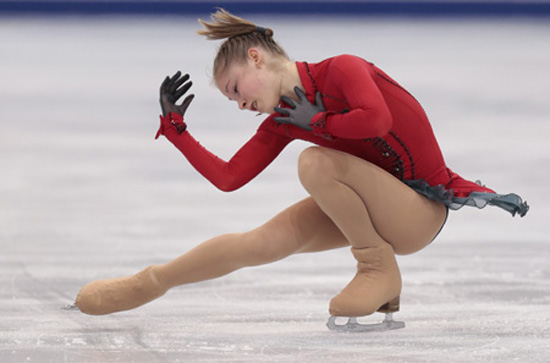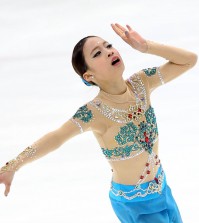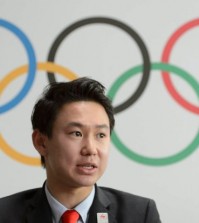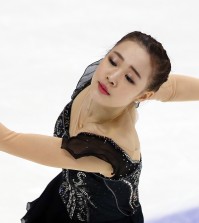- California Assembly OKs highest minimum wage in nation
- S. Korea unveils first graphic cigarette warnings
- US joins with South Korea, Japan in bid to deter North Korea
- LPGA golfer Chun In-gee finally back in action
- S. Korea won’t be top seed in final World Cup qualification round
- US men’s soccer misses 2nd straight Olympics
- US back on track in qualifying with 4-0 win over Guatemala
- High-intensity workout injuries spawn cottage industry
- CDC expands range of Zika mosquitoes into parts of Northeast
- Who knew? ‘The Walking Dead’ is helping families connect
Yu-na, look out for Russian skaters!
New generation of prodigies emerges with sensational jumps, polished artistry

A dominant skater in this Olympic season, Russia’s Julia Lipnitskaia is the favorite to win the Grand Prix Finals in Fukuoka, Japan, which begins Thursday. (AP-Yonhap)
By Do Je-hae
Russia has been a traditional frontrunner in all disciplines of figure skating, except for the ladies event. That is about to change.
For the first time in decades, Russia is emerging as a serious contender in the ladies’ competition, thanks to a group of teenage skaters equipped with the utmost technical ability and polished artistry.
A leader in a wave of Russian skating prodigies is Julia Lipnitskaia, the most dominant skater on the Grand Prix circuit in this Olympic season after sweeping two consecutive events at Skate Canada and the Cup of Russia over the last few weeks. The 15-year-old will compete at the Grand Prix Finals in Fukuoka, Japan, which will take place Thursday through Sunday.
The Grand Prix Series, now in its 19th year, consists of six international events in a cumulative point-scoring format. Around 300 athletes from 30 countries have competed in the series this season.
Russian dominance in ladies figure skating is apparent in the Grand Prix Finals lineup, the most important skating event after the Olympics and the World Championships. Four of the six finalists are Russian — Lipnitskaia, Anna Pogorilaya, Adelina Sotnikova and Elena Radionova. The other two finalists are Asada Mao of Japan and Ashley Wagner of the U.S.

Kim Yu-na will compete in her first competition ahead of the Sochi Games at the Golden Spin of Zagreb in Croatia starting Friday. (AP-Yonhap)
At her best, Lipnitskaia is what great ladies’ figure skating is all about. The 2012 Russian junior champion is an arresting beauty who moves like an ice dancer rather than a singles competitor. In her first year as a senior skater, she already seems to have it all — speed, elegance, musicality, uncanny flexibility, and most importantly, the jumps. The intricacy of her footwork, the consistency of her triples and a mature expressiveness are way beyond her years.
During the Cup of Russia last week, Eurosport commentators were in complete awe of the15-year-old, predicting that she could “win the Olympics and be the youngest-ever winner.”
Lipnitskaia’s first step to Sochi would be to make the Russian Olympic team. And if she does, she will be a contender for a place on the podium with Kim Yu-na, who will compete in Sochi with two other skaters Park So-yeon and Kim Hae-jin.
The Russian figure skating team for Sochi has not been finalized. Russia will send only two atheletes to the female division based on the results of the nationals later this month.
“I think Lipnitskaia is going to be a contender at Sochi. The field of Russian ladies is pretty deep, but she is my top pick,” said 1998 Olympic champion and NBC commentator Tara Lipinski. “There is something about her that draws you in. There is a good combination of the technical aspect and artistry.” Lipinski knows what it’s like to compete at an elite level as a teenager, having won her Olympic title for the U.S. at age 16 in Nagano, Japan, over teammate and skating legend Michelle Kwan.
Lutz-toe combination
One of the most impressive aspects of Lipnitskaia’s skating is that she has the most consistent triple lutz-triple toe combination after reigning Olympic champion Kim Yu-na. This move has been crucial to the Olympic success of champions like Kim at the 2010 Vancouver Games and Kristi Yamaguchi at the 1992 Games in Albertville, France.
The triple lutz-triple toe is the most difficult combination being performed in the ladies’ event. It has been so since the early 1990s, when Yamaguchi started to incorporate the routine in her free skate to counter her chief rival Ito Midori’s sensational triple axel.
But after Yamaguchi, the combination largely disappeared from the competition until Kim brought it back in 2010 as a weapon against her then-rival Asada Mao’s jumping prowess that included an erratic triple axel.
Although not as breathtaking in elevation or distance as Kim’s, Lipnitskaia’s lutz-toe combination has been mostly consistent this season.
This combination wasn’t a part of Kim’s routine until she arrived in Vancouver at age 19. Lipnitskaia also has a secure technique on the flip and loop, the most difficult jumps after the lutz, and she is one of the finest and most innovative spinners at the moment.
How serious of a challenge could Lipnitskaia be to Kim, if the Russian makes it to the Olympics? Even with all her skills, she will not be able to skate to her full potential unless she becomes a mentally strong competitor.
Due to her inexperience, nerves seem to be one of her weaknesses. During the Cup of Russia event, her confidence was shaken when she missed her opening combination.
“I am happy to qualify for the Grand Prix Final with two first places, but I am not satisfied with my free skating. I was very nervous and when the first jump didn’t work, I wasn’t able to pull myself together,” the skater said during a press conference after she won the event.
During the upcoming Grand Prix Finals, all eyes will be on the diminutive Russian who overcame a growth spurt last year to establish herself as a future star in her sport. Her skating is generating more talk and excitement than Asada, whose desperate obsession with the triple axel has sometimes been a source of ridicule rather than admiration in the Korean press.
The local media will be more interested covering the Golden Spin of Zagreb in Croatia, which will take place during the same period as the Grand Prix Finals, simply because it will be Kim’s first competition of the season. Kim has been sidelined from the Grand Prix series this season with a foot injury and has not yet had the chance to perform her new programs in competition. She departs for Zagreb today.
“Overall, I feel that I have recovered about 70 percent of my usual condition,” Kim said during a press conference in October in Seoul. “Unlike in previous seasons, I have chosen a fast-paced accompaniment to the free skate, so I need to be in great condition physically to catch up with the music.”
Her short program is set to “Send in the Clowns” and her free skate to Astor Piazzolla’s “Adios Nonino.” She has called them the “most taxing, yet rewarding programs of my career.”
The biggest focus for Kim in the next few weeks until the Olympics will be to get comfortable with these new programs. The 23-year-old will have had only one chance to perform them in competition before the last big event of her career. Other contenders, including Asada, have been competing consistently in preparation for the Olympics without injury.
The winners of both the Grand Prix Finals and the Golden Spin of Zagreb will be serious contenders for the podium in Sochi.
The ladies event at the Olympics will take place on Feb. 19 and 20. If Kim wins, she will become the first since Germany’s Katarina Witt (gold medalist at the 1984 Sarajevo and 1988 Calgary Games) to clinch back-to-back Olympic titles.















